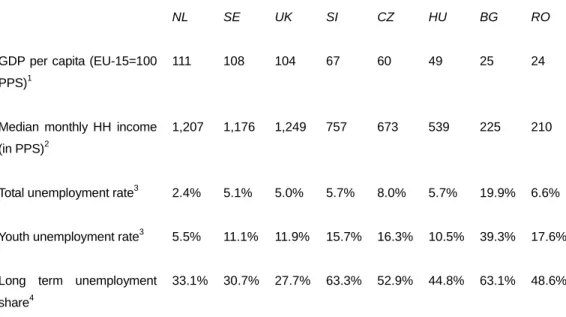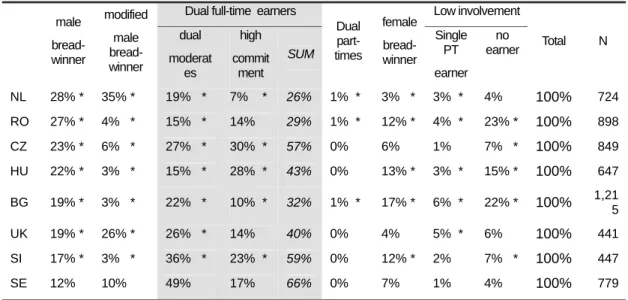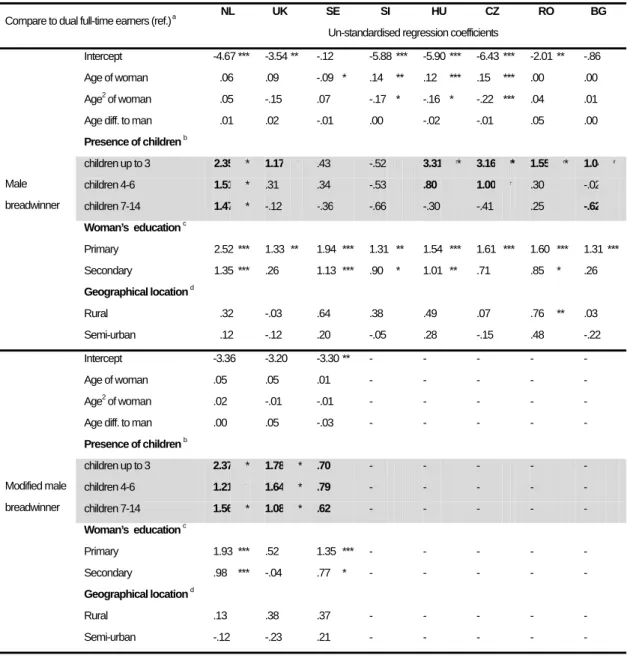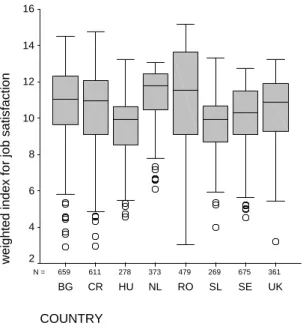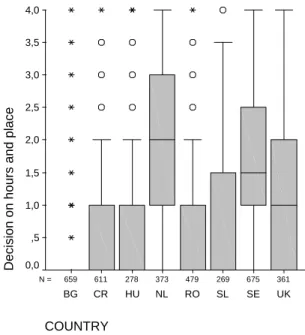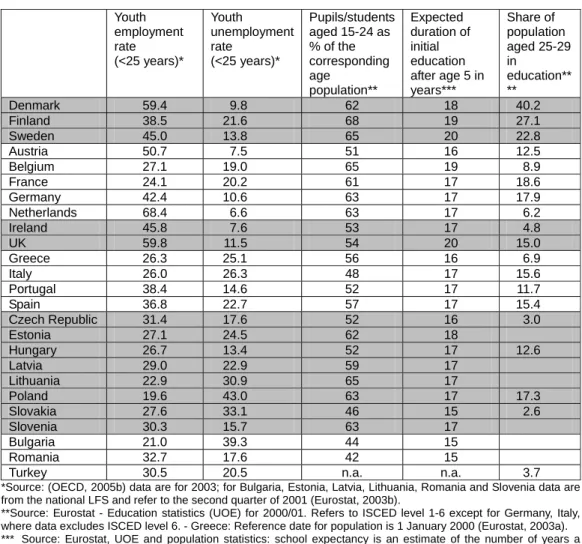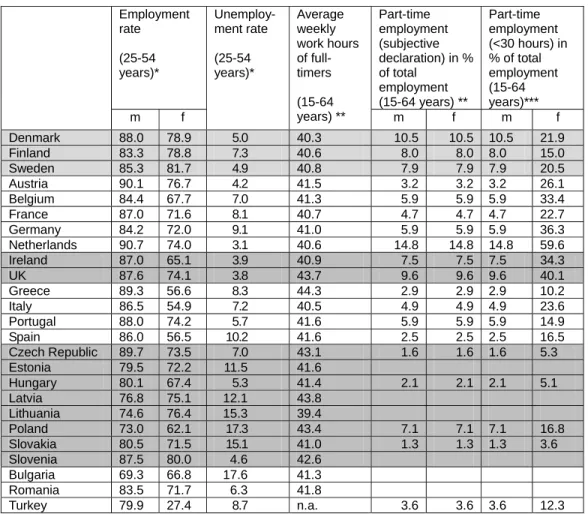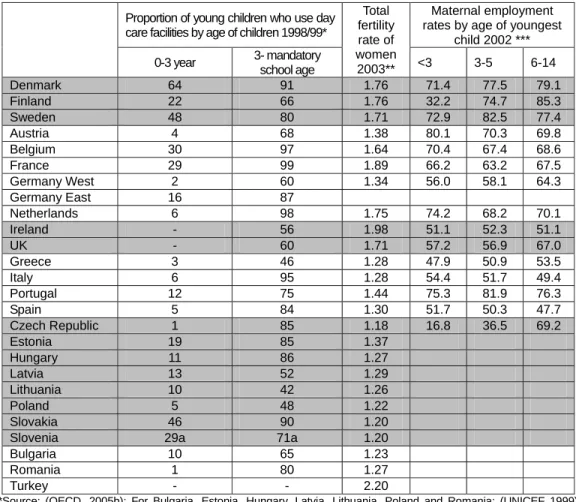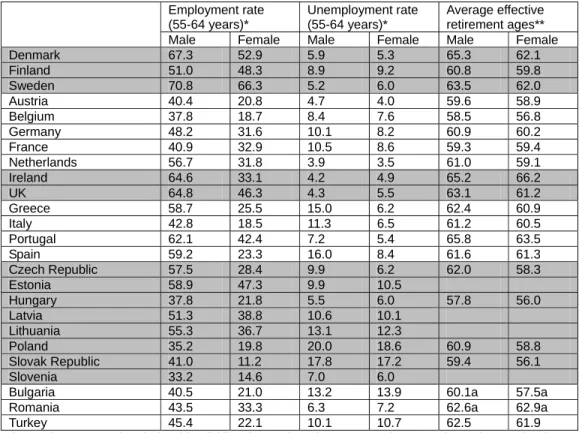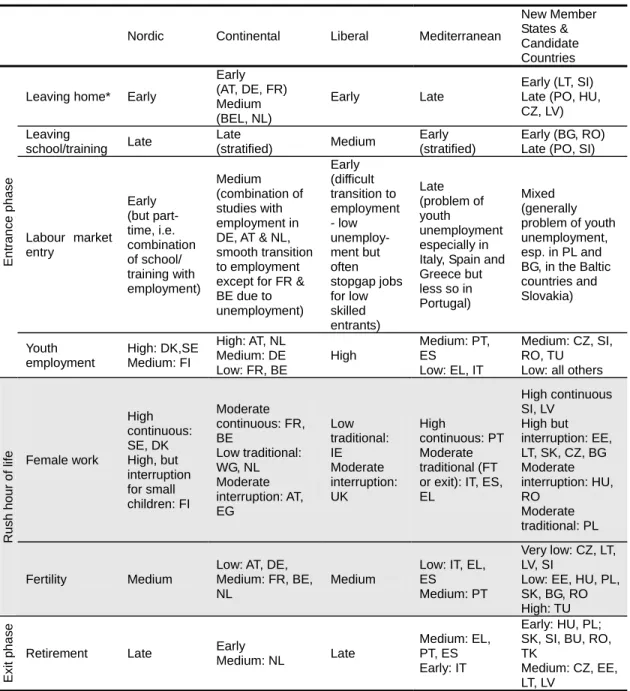The Relationship between Home and Work in an Enlarged Europe: A Quantitative Analysis
Barbara Haas
Nadia Steiber
Margit Hartel
Claire Wallace
Title:
The Relationship between Home and Work in an Enlarged Europe: A Quantitative Analysis
ISSN: Unspecified
2006 Institut für Höhere Studien - Institute for Advanced Studies (IHS) Josefstädter Straße 39, A-1080 Wien
E-Mail: o ce@ihs.ac.at ffi Web: ww w .ihs.ac. a t
All IHS Working Papers are available online: http://irihs. ihs. ac.at/view/ihs_series/
This paper is available for download without charge at:
https://irihs.ihs.ac.at/id/eprint/1742/
The Relationship between Home and Work in an Enlarged Europe
A quantitative analysis
Barbara Haas; Nadia Steiber; Margit Hartel and Claire Wallace
Sociological Series
Sociological Series
The Relationship between Home and Work in an Enlarged Europe
A quantitative analysis
Barbara Haas, Nadia Steiber, Margit Hartel and Claire Wallace November 2006
Institut für Höhere Studien (IHS), Wien
Institute for Advanced Studies, Vienna
Contact:
Barbara Haas : +43/1/31336-4745
email: Barbara.Haas@wu-wien.ac.at Margit Hartel
email: Margit.Hartel@univie.ac.at Nadia Steiber
email: nadia.steiber@nuffield.ox.ac.uk Claire Wallace
email: Claire.Wallace@abdn.ac.uk
Founded in 1963 by two prominent Austrians living in exile – the sociologist Paul F. Lazarsfeld and the economist Oskar Morgenstern – with the financial support from the Ford Foundation, the Austrian Federal Ministry of Education, and the City of Vienna, the Institute for Advanced Studies (IHS) is the first institution for postgraduate education and research in economics and the social sciences in Austria. The Sociological Series presents research done at the Department of Sociology and aims to share “work in progress” in a timely way before formal publication. As usual, authors bear full responsibility for the content of their contributions.
Das Institut für Höhere Studien (IHS) wurde im Jahr 1963 von zwei prominenten Exilösterreichern – dem Soziologen Paul F. Lazarsfeld und dem Ökonomen Oskar Morgenstern – mit Hilfe der Ford- Stiftung, des Österreichischen Bundesministeriums für Unterricht und der Stadt Wien gegründet und ist somit die erste nachuniversitäre Lehr- und Forschungsstätte für die Sozial- und Wirtschafts- wissenschaften in Österreich. Die Reihe Soziologie bietet Einblick in die Forschungsarbeit der Abteilung für Soziologie und verfolgt das Ziel, abteilungsinterne Diskussionsbeiträge einer breiteren fachinternen Öffentlichkeit zugänglich zu machen. Die inhaltliche Verantwortung für die veröffentlichten Beiträge liegt bei den Autoren und Autorinnen.
enlarged Europe with a special focus on gender aspects and on cross-national settings embedded in different welfare state architecture. First, we deal with the determinants of cross-country variations in gendered employment patterns by drawing on the ‘Households, Work and Flexibility’ (HWF) survey. Second, we use these data to investigate which factors make employees more or less satisfied with their jobs, with a special focus on gender aspects. Third, we look at employment patterns from a life course perspective in an enlarged Europe by using official data from various sources (OECD, Eurostat). Finally, drawing on the Eurobarometer Surveys on Time Use EB 60.3 (EU-15) and CCEB 2003 (Candidate Countries), we investigate female labour market participation over the life course.
Zusammenfassung
Das vorliegende Projekt untersucht die komplexe Beziehungsstruktur zwischen Erwerbsarbeit und Privatleben in acht west- und osteuropäischen Ländern. Zunächst werden die Determinanten geschlechtsspezifischer Arbeitszeitmuster in den ausgewählten Ländern analysiert. Als Datenquelle dient eine internationale, im Rahmen des Fünften Rahmenprogramms durchgeführten Umfrage (‚Households, Work and Flexibility’ HWF). Im zweiten Kapitel untersuchen wir auf Basis der gleichen Datenquelle mögliche Einflussfaktoren auf die Berufszufriedenheit und fokussieren dabei geschlechtsspezifische Differenzen. Ausgehend von offiziellen Datenquellen (EUROSTAT und OECD) werden im dritten Kapitel Erwerbsmuster aus einer Lebensverlaufsperspektive im Überblick dargestellt.
Im letzten Kapitel nutzen wir diese Hintergrundinformationen sowie eine zusätzliche Datenquelle (Eurobarometer für Zeitverwendung, EB 60.3 und CCEB 2003 für die Kandidatenländer), um zu einem besseren Verständnis des länderspezifischen Erwerbsverhaltens von Frauen im Lebensverlauf beizutragen.
Keywords
Keywords: household employment patterns, female labour market participation, welfare states, East-West comparison, job satisfaction, empirical quantitative analysis
Schlagwörter
Schlagwörter: Erwerbsmuster, Haushaltsebene, Frauernerwerbsarbeit, Wohlfahrtsstaats-
vergleiche, Ost-West Vergleiche, Berufszufriedenheit, quantitativ-empirische Untersuchung
Remarks
This is part of the final report of the project „The relationship between home and work in eight European countries. A quantitative analysis“ (Projektnummer: 11029) which has been funded by the Austrian Jubilee Fund in Vienna, duration of the project: August 2004 to September 2006.
Bemerkungen
Beim vorliegenden Bericht handelt es sich um einen Endbericht des vom Jubiläumsfonds der Oesterreichischen Nationalbank finanzierten Projekts mit dem Titel „The relationship between home and work in eight European countries. A quantitative analysis“ (Projektnummer: 11029), Projektdauer:
August 2004 bis September 2006
Introduction 1
Chapter 1: Household employment patterns in an enlarged
European Union 5
Introduction ... 5
The Theoretical Framework ... 6
Data... 7
The Structural and Cultural Context: A Comparison of Countries ... 8
The policy framework ... 10
The gender cultural context... 11
Main hypotheses ... 13
The empirical analysis of household employment patterns ... 14
The ‘child-effect’ ... 15
Discussion... 19
Conclusions... 20
References... 21
Chapter 2: How does flexibility and control affect job satisfaction?25
Introduction ... 25The theoretical Framework ... 26
Cross-national differences: Employee-lead versus employer-lead flexibility regimes... 28
The debate about job satisfaction ... 29
Research hypotheses ... 30
Data... 32
Operationalisation ... 32
Results ... 34
Conclusions... 39
References... 41
Chapter 3: Employment patterns from a life course perspective in an enlarged Europe. 45
Introduction ... 45Employment patterns in the different stages over the life course... 47
Main working phase: the ‘rush hour of life’... 50
Exit phase: empty nest and pre-retirement phase ... 55
References... 60
Empirical Analysis of Paid Time Use over the Life course ... 66 Conclusions... 73 References... 74
Summary 76
References... 78
Introduction
The principle aim of this project was to investigate the relationship between home and work in eight Western and Eastern European countries. The present research report is structured as follows: In Chapter 1, we deal with the determinants of cross-country variations in gendered employment patterns. This chapter has been accepted for publication in the peer- reviewed journal Work, Employment and Society. Drawing on the ‘Households, Work and Flexibility’ (HWF) survey deriving from a Fifth Framework Programme project (2000-2003), we look at which household employment patterns prevail in which parts of Europe and how women’s and men’s patterns of labour market integration are affected by the presence of children. The countries covered are: Bulgaria (BG), the Czech Republic (CZ), Hungary (HU), the Netherlands (NL), Romania (RO), Slovenia (SL), Sweden (SE) and the United Kingdom (UK). In Chapter 2 we investigate which factors make employees more or less satisfied with their jobs, thereby focusing on the explanation of gender and cross-national differences in the level of job satisfaction. For this, we also use the HWF survey. In Chapter 3, we look at employment patterns from a life course perspective in an enlarged Europe. We draw on official data from various sources (e.g. OECD, Eurostat) to trace back the institutional framework for the employment and unemployment patterns in an enlarged Europe. In
Chapter 4, we look at female labour market participation over the life course in an enlargedEurope. Drawing on empirical survey evidence of the Eurobarometer Surveys on Time Use EB 60.3 (EU-15) and CCEB 2003 (Candidate Countries Eurobarometer), we describe cross- national differences in female labour market participation from a life course perspective.
Overall, the report contributes to our knowledge about labour market behaviour in an enlarged Europe with a special focus on gender aspects and on cross-national settings embedded in different welfare state architecture. The final section of the report presents our conclusions about what can be learned from our insights and we refer to questions which still present important challenges to be tackled by future studies.
The main aspects about these four chapters can be summarized as follows:
Chapter 1: Household employment patterns in an enlarged European Union
This chapter aims to contribute to our understanding of why different models of work-care
integration prevail in different parts of Europe. Hereby, we explore how the empirical
evidence in the HWF survey-data corresponds to the conventional theories about the
determinants of cross-country variations in gendered employment patterns. More precisely,
we analyse the parallels and contradictions between the institutional setup and its potential
impact on gendered employment patterns (structures), prevalent ideals about the ‘best’ way
to combine work and caring responsibilities (cultures) and the actual division of paid work
within couple households (practices). Referring to the practices in paid working time, we
theoretically distinguish five different household types, namely the dual earners, the male breadwinner, the modified male breadwinner, the female breadwinner and the low involvement household. In a first step, we show which types predominate in which countries.
Next, in a multinomial logistic regression framework, we investigate how the presence of (small) children shapes the division of paid labour between men and women in different national contexts and for what structural and cultural reasons. The findings call for a further elaboration of conventional theories of gendered employment patterns when applied to an enlarged Europe.
Chapter 2: How does flexibility and control affect job satisfaction?
This chapter compares the relationship between flexible employment and job satisfaction in employer-lead and employee-lead flexibility regimes. In a cross-national comparison we explore whether job satisfaction is affected by the extent of flexible employment and by employees’ ability to control their working conditions (time issues and place of work). The chapter further considers if gender and the family situation (presence of young children) affect the way in which job satisfaction and flexible employment interact, testing the assumption that women are more satisfied with flexible jobs because they are more committed to their family responsibilities than are men. For this, we draw on the international
‘Households, Work and Flexibility’ (HWF) survey carried out in 2001 in eight countries of Eastern and Western Europe, which represent different approaches to flexibility: On the one hand, we investigate employee-lead flexibility regimes represented by the Netherlands and Sweden. On the other hand, we look at more employer-lead flexibility regimes: Bulgaria, the Czech Republic, Hungary, Romania, Slovenia and UK. The research shows that in the employee-lead regimes the ability to decide over time and place issues is an important factor contributing to job satisfaction, whereas in the employer-lead regimes earning enough money and having a permanent contract play a crucial role for both sexes.
Chapter 3: Employment patterns from a life course perspective in an enlarged Europe
This chapter explores employment patterns of Europeans along their life-course by drawing
on official data sources from EUROSTAT and the OECD. Since the debates about welfare
state typologies to understand cross-national differences still heavily rely on the classification
by Esping-Andersen (1990), our contribution to this debate is to take on a more dynamic
perspective upon the developments of labour market participation. In this vein, an important
challenge is to better understand the dynamics in employment patterns by studying
variations in three distinct life course phases. Beginning with the phase of labour market
entrance, we investigate in which European countries people start their working career early
or late. Next, we analyse the main working phase which can also be a sort of ‘rush hour of
life’ as the majority of employees has to combine work with other life domains. Finally, we
draw our attention to the fact that there are strong cross-national differences about when
employees leave the labour market. The principle aim of this chapter is to gain an overview
about different employment patterns in 25 Eastern and Western European countries. To deepen our understanding about major issues in how to increase employment rates, we first have to know what the labour markets in different parts of Europe look like. This is especially important against the background of an enlarged Europe. This description provides a basis for additional studies addressing more the explanations for why countries differ a lot when considering labour market participation from a life course perspective.
Chapter 4: Female labour market participation over the life course in an enlarged
Europe.This chapter draws on a representative sample from the Eurobarometer Surveys on Time
Use EB 60.3 and the CCEB 2003 (Candidate Countries Eurobarometer) to map female
employment transitions over the life course in 28 countries (EU-25 plaus Bulgaria, Romania
and Turkey). We explore whether observed patterns reflect conventional welfare state
regime typologies or classifications of breadwinner models in Europe with a special interest
in the Central and Eastern European countries, which are typically subsumed under the
post-socialist regime type. Our results suggest an elaboration of former welfare state
typologies with regard to female labour market participation.
Chapter 1: Household employment patterns in an enlarged European Union
1Barbara Haas, Nadia Steiber, Margit Hartel and Claire Wallace
AbstractWith the aim of contributing to our understanding of why different practices concerning the gender division of paid labour in couple households prevail in different parts of Europe, we empirically investigate the distribution of dominant ‘household employment patterns’ in eight countries including Bulgaria, the Czech Republic, Hungary, the Netherlands, Romania, Slovenia, Sweden and the United Kingdom. Based on comparative survey evidence (N=10,123), we explore how national differences in terms of the actual gender division of paid work (practices) correspond with what well-established ‘structuralist’ and ‘culturalist’
theories about the determinants of cross-country variations in gendered employment patterns would predict. The findings call for a further elaboration of conventional approaches to explaining gendered employment patterns in an enlarged Europe.
Introduction
Western European countries have witnessed a large influx of mothers into the labour force in the last decades (e.g. Ellingsaeter 1999; Blossfeld & Drobnic 2002). This has rendered the question of how parents can reconcile their work and family responsibilities increasingly salient. In Eastern and Central European (ECE) countries, by contrast, problems of work- care integration have not been a central topic of debate. Women traditionally worked full-time while the state supported the care of children, although retrenchment in the welfare system means that this is now changing. However, on account of cross-country differences in the structural and cultural context in which couples decide on how to divide their paid and unpaid work responsibilities between themselves, gendered employment patterns still vary considerably across countries.
The present paper aims to contribute to our understanding of why different models of work- care integration prevail in different parts of Europe. Hitherto, research in this area has mainly focused on socio-political regulations and/or predominant views concerning the ‘ideal’
division of labour between the sexes, whilst the actual practices within households in terms of the gender division of labour are largely unexplored, especially for Eastern European countries. We aim to test the applicability of conventional theories about the determinants of
1 “This paper has been accepted for publication in Work, Employment & Society and will be published in Work, Employment & Society, 20/4, December/2006 by SAGE Publications Ltd, All rights reserved. © BSA Publications Limited. For more information please visit: www.sagepub.com .”
cross-country variations in gendered employment patterns (e.g. Lewis 1992; 2002; Pfau- Effinger 1998; Sainsbury 1996) when applied to an enlarged Europe. Based on a specifically designed survey that looked at household and not just individual employment patterns carried out in 2001, we investigate the ways in which paid work is actually divided in couple households in five Eastern European countries (Bulgaria, the Czech Republic, Hungary, Slovenia and Romania) and in three Western ones (the Netherlands, Sweden and the United Kingdom). First, we explore which household employment patterns predominate in these countries and then go on looking at how the presence of children shapes the division of paid labour within couple households. Finally, we compare prevalent household employment patterns (practices) with what the institutional setup supports, the socio-economic conditions allow (structures), and with what the gender cultural context prescribes (cultures). In this way, we aim to shed new light upon the determinants of cross-national differences in gendered employment patterns.
The Theoretical Framework
There is a large quantity of empirical research on the potential influence of the institutional context on female labour supply (e.g. Uunk et al. 2005, Gornick & Meyers 2003; Stier &
Lewin-Epstein 2001). In such studies either well-established typologies of gendered welfare state regimes (e.g. Lewis 1992; Sainsbury 1996) or specific policy arrangements (e.g. child care provision, leave or tax systems) are used to explain cross-country-variations in women’s paid work involvement. A weakness of such ‘structuralist’ approaches (Haas 2005) lies in the assumption that women’s labour market behaviour can be directly read off from policies, which is not necessarily the case (Daly 2000). Welfare state typologies understate the complexity of the variation in policies across countries and the resulting structure of opportunities and constraints for women. An important theoretical contribution to our understanding of why actual practice in terms of the gender division of labour may differ from what the policy context favours, are so-called ‘culturalist’ approaches (Haas 2005). These are concerned with the historical evolution of societal ideals concerning the gender division of labour (‘gender cultures’) that are argued to shape policy-decisions and actual practices in terms of the gender division of labour (e.g. Pfau-Effinger 1998; 2004; Blossfeld & Drobnic 2002).
Both ‘structuralist’ and ‘culturalist’ approaches have their merits and explanatory power to
explain cross-country variations in women’s work involvement. However, just as gendered
employment behaviour cannot directly be read-off from policies, not least due to economic
constraints, it also does not necessarily follow prevalent ideas in a society about the ideal
way of dividing the work between the sexes (Pfau-Effinger 2004). Furthermore, these
dominant theories have been developed and tested in the context of affluent North-Western
societies, and cannot simply be transposed to different societal contexts; neither to Southern
Europe (Uunk et al. 2005) nor to post-socialist countries, as the present paper sets out to show.
Building on the insights of both approaches, the paper explores cross-country variations along three dimensions: institutional structures, gender role norms and actual practices in terms of the gender division of paid work in couple households. Following Pfau-Effinger (2004), we recognise that these three analytical dimensions are highly interdependent, yet they may not always follow from one another. They can develop in different directions thereby contributing to the emergence of contradictions in the relationship between gender policies, cultural orientations and actual household practices. The aim of the paper is to show that actual practices in terms of the gender division of labour may differ from what we would expect when drawing on conventional theories on the impact of the policy arrangements and/or the gender cultural context on female labour supply. With the aim of understanding such incongruities between theoretical expectations and actual practices, we investigate the impact of economic and labour market conditions as a crucial aspect of the structural context on how paid and unpaid work responsibilities between women and men are divided. In this way we aim to take account of the fact that individuals may not be able to practise the household employment pattern they would prefer if their financial situation allowed. For instance, whilst the gender culture and/or the policy context may favour women’s roles as full-time mothers and homemakers, it is only in more affluent societies that significant shares of women are able to put this into practice. In less prosperous countries and within households of lower socio-economic status, by contrast, most women have to pursue paid work to support their families instead.
We start with a cross-country comparison in terms of the policy context, economic and labour market conditions and the gender cultural context. Then we empirically investigate national variations in the distribution of household employment patterns and look at the extent to which women reduce their paid work involvement when they have children. This is commonly argued to be the main mechanism driving different distributions of household employment patterns across countries (Stier & Lewin-Epstein 2001). Empirical evidence in these respects is then compared with what we would expect to find when drawing on ‘structuralist’ or
‘culturalist’ approaches to the explanation of cross-country differences in the gender division of labour. Finally, we assess what economic necessity of working may add to the explanation of cross-country variations.
Data
For the empirical investigation of household employment patterns, we draw on a cross-
country comparative data set collected in spring 2001 within the ‘Households, Work and
Flexibility’ project (HWF), which was funded by European Commission under the Fifth
Framework Programme (Wallace 2003). The survey was based on random samples of
adults yielding a total sample of 10,123. To take account of cross-country differences in tertiary education and early retirement rates, we focus on prime age households in which both partners are between 20 and 60 years of age, resulting in a total sample of 6,000 couple households in eight countries. As the HWF data does not provide information on gender cultural contexts, we additionally draw on data from the 2002 International Social Survey Programme and the European Values Study 1999/2000.
Weekly working time in paid employment was measured asking respondents how many hours they and their partners usually work in their main as well as in additional economic activities. For the analysis a summary measure of hours performed in all economic activities was computed that was then combined with the weekly work hours performed by respondents’ partners to form seven different household employment patterns. These were not derived through empirical clustering but defined a priori to resemble the household employment strategies most discussed in the literature and frequently found in policy documents: Accordingly, male breadwinner households are defined as couple households in which the man works full-time, while the woman is economically inactive (e.g. housekeeper, in education, pensioner, unemployed, disabled or sick). Modified male breadwinner households comprise a full-time working man and a part-time working woman. As the definition of part-time employment varies across countries, we decided to adopt the threshold proposed by the OECD (van Bastelaer & Lemaitre 1997) and to define part-time work as performing less than 30 hours of paid work per week. In households termed dual moderates both partners work full-time neither of them working more than 48 hours per week. This is contrasted with high commitment households in which both work full-time with at least one of the partners having a very long workweek of 48 hours or more (set as the working hours limit in the European Working Time Directive). In dual part-time earner households the man and the woman are working less than 30 hours per week. In Female breadwinner households the woman works full-time while her partner is either not employed or working part-time. Finally, the residual category, termed low involvement households, comprises all households in which none of the partners is gainfully employed or in which only one of the partners works part-time.
The Structural and Cultural Context: A Comparison of Countries Economic development and labour market characteristics
In terms of the economic development (GDP per capita) the Western European countries
under consideration are most advanced followed by Slovenia and the Czech Republic. Next
in the ranking is Hungary, while Bulgaria and Romania are much less prosperous. A rather
similar country ranking emerges when looking at the medium monthly household net income
(see Table 1). A major factor contributing to the lower economic well-being in ECE countries
is the problem of unemployment, which is of particular salience in Bulgaria, where the total
unemployment rate amounted to about 20% in 2001 (Table 1). Furthermore, the share of unemployed people aged 15-24 as a proportion of the labour force in the same age bracket amounts to 39%. Also in Slovenia, the Czech Republic and Romania, the youth unemployment rate surmounts 15%. Furthermore, long-term unemployment tends to be more severe in ECE countries than in Western Europe. The share of those unemployed for at least a year among the unemployed amounts to more than 50% in most ECE countries as compared to less than a third in the Netherlands, Sweden and the United Kingdom. In combination with the lack of long-term benefits and assistance in most of these countries, this results in rapidly growing numbers of families living under the poverty line (Herczog 2000).
Table 1: Indicators of the socio-economic and labour market conditions, 2001
NL SE UK SI CZ HU BG RO
GDP per capita (EU-15=100 PPS)1
111 108 104 67 60 49 25 24
Median monthly HH income (in PPS)2
1,207 1,176 1,249 757 673 539 225 210
Total unemployment rate3 2.4% 5.1% 5.0% 5.7% 8.0% 5.7% 19.9% 6.6%
Youth unemployment rate3 5.5% 11.1% 11.9% 15.7% 16.3% 10.5% 39.3% 17.6%
Long term unemployment share4
33.1% 30.7% 27.7% 63.3% 52.9% 44.8% 63.1% 48.6%
1 Sources: Eurostat (2004a; 2004b). The figures take account of differences in price levels between countries by measuring GDP in terms of Purchasing Power Standards (PPS). This is an artificial common currency where differences in prize levels between countries are eliminated by using Purchasing Power Parities (PPP). The figures are in reference to the EU-15 average set to 100.
2 Source: European Foundation (2003). The measures have been adjusted for differences in household size and composition (modified OECD scale) and converted into purchasing power standards (PPS) to allow for comparisons across countries.
3 Source: European Commission (2002). The unemployment rate is defined as the number of registered unemployed % of the labour force (employed and unemployed aged 15-64). The youth unemployment rate is the share of unemployed as % of the labour force aged 15-24.
4 Source: Eurostat (2002). This refers to long-term unemployed population (≥12 months) as a proportion of total unemployed population.
In Eastern Europe there has since long been a tradition of full-time work for both women and
men. Because of low real wages, in ECE countries average full-time wages are often
insufficient to cover a family’s minimum cost of living. Hence, the financial incentives to work
for both men and women tend to be rather strong when compared to Western European
countries. In addition, employers are reluctant to provide part-time jobs that are thought to involve too high an administrative burden. For these reasons it is not surprising that part-time work – here, defined as working less than 30 hours per week – is very uncommon among women in most ECE countries, while it is rather wide-spread in the UK and the Netherlands.
Sweden, usually described as a country where female part-time employment is of rather strong importance, has similarly low rates of female part-time employment as Romania or Bulgaria when adopting the 30 hours threshold (see Table 2).
Table 2: Working time practices, 2001
NL SE UK SI CZ HU BG RO
Male part-time rate 3.8% 4.3% 6.7% 6.7% 5.1% 6.4% 12.3% 8.9%
Female part-time rate 50.5% 13.8% 40.5% 10.9% 9.5% 9.2% 12.6% 15.2%
Men working more than 40 hours
38.6% 41.2% 55.8% 51.7% 68.5% 72.1% 39.4% 56.7%
Women working more than 40 hours
9.6% 22.4% 15.9% 32.4% 51.5% 58.8% 32.4% 38.4%
Source: HWF Survey 2001. Part-time rates are defined as the number of male/female workers (dependent employees and self-employed) performing less than 30 hours per week of paid work as a % of all male/female workers. The bottom rows report the number of men/women working more than 40 hours per week, as a % of all workers (working hours are the sum of paid working hours in the main and second jobs).
Conversely, working more than 40 hours per week tends to be more widespread in ECE countries than in most Western European societies. The notable exception is the UK, where among men (but not women) ‘long hours working’ is even more common than in some ECE countries (Table 2). The highest share of working more than 48 hours and hence more than the work hours limit set out in the European Working Time Directive, is found among Hungarian and Romanian men (about 50%), followed by their Czech, British and Slovenian counterparts (about 40% respectively, not shown). The lowest shares are found in Sweden, the Netherlands and Bulgaria.
The policy framework
Sweden is usually described as a state that is actively supporting a dual earner/dual-carer
system with generous support for parental leave and encouragement for full-time
employment of both men and women through the provision of extensive and affordable child
care facilities (e.g. Bjornberg 2002). In the Netherlands it is the promotion of more flexible
and especially reduced working hours that is seen as the way to combine work and care
(Cousins & Tang 2004). However, institutional arrangements are not designed to facilitate the combination of parenthood with employment. In the absence of facilities for child care, female part-time employment has evolved as the dominant solution for work-care integration, while men largely continue to work full-time (Visser 2002; Plantenga 2002). Also in the UK, child care is primarily seen as a private problem to be solved by families and/or through market mechanisms with the result that there is a severe lack of affordable child care provision (Dex 1999). Hence, similarly to the Netherlands, part-time work is the dominant strategy for women to combine work and family responsibilities (Cousins & Tang 2004).
In ECE countries, before transition, we found a universal welfare state that supported the full-time labour market involvement of both men and women with the provision of child care facilities that were available almost round the clock. In addition, policies provided for generous child care leave. In the period since 1989, however, these systems have evolved in different directions. Today, Slovenia most resembles Sweden in terms of social and family policies. We find extensive and affordable child care facilities for children of all ages (Sicherl et al. 2003) as well as a generous support during twelve months of parental leave (Stropnik 2001). By comparison, in the Czech Republic and Hungary, the institutional support for working mothers of small children is rather weak. With the intention of tackling unemployment by way of removing women from the labour force (Zöldy-Szita & Hagedus 2000) but also with the aim to foster a more conservative model of the family, a system of extended care leave has been introduced through a child rearing allowance for four years in the Czech Republic and three years in Hungary (Vecernik 2003; Koncz 2002; Herczog 2000). At the same time the provision of nurseries has been severely reduced. However, the provision of care facilities for older children has been much less affected by transition policies. In both countries most children aged above three attend kindergartens (Wallace &
Mateeva 2004; Kocourová 2002; Herczog 2000; Koncz 2002). In contrast, Romania and Bulgaria have severely reduced their support to families. The originally highly subsidised system of child care has largely disappeared. As a consequence, the period since 1989 has been characterised by a rapid drop in the availability and use of state-run child care (Meurs
& Giddings 2004, Fong & Lokshin 2000).
The gender cultural context
The majority of women in ECE countries worked full-time under communism. However,
despite the traditional predominance of such an ‘egalitarian’ model with respect to labour
market involvement, equality in these terms seems to co-exist with rather conservative
conceptions of family and gender roles (e.g. Crompton et al. 2005; Robila & Krishnakumar
2004; Siemienska 2000; Herczog 2000). Drawing on cross-country comparable attitudinal
data (Table 3), we find an East-West divide in terms of the traditionalism of gender role
attitudes. For instance, while in the Czech Republic more than half of the population
(strongly) agree with the statement: ‘A man’s job is to earn money; a woman’s job is to look
after the home and family’, this share amounting to 45% in Bulgaria, 40% in Hungary and 30% in Slovenia, the support for a traditional gender role allocation is weaker in the Western European countries under consideration (below 20%), and particularly so in Sweden (8%).
Table 3: Gender role attitudes, 2000/2002
NL SE UK SI CZ HU BG RO Traditional gender role
allocation1
12.3%
(2.2)
7.6%
(1.9)
17.7%
(2.4)
29.4%
(2.7)
50.6%
(3.3)
39.5%
(3.2)
44.8%
(3.3) - Women’s identity as
mothers2
34.4%
(2.2)
40.4%
(2.2)
44.3%
(2.4)
64.7%
(2.8)
60.1%
(2.8)
70.2%
(3.0)
75.7%
(3.0)
85.0%
(3.2) Demand for female
breadwinner3
37.9%
(2.4)
89.2%
(3.4)
70.4%
(2.8)
91.0%
(3.3)
92.7%
(3.4)
89.4%
(3.4)
91.8%
(3.3)
85.2%
(3.3) Source: ISSP 2002 and EVS 1999/2000
1 Agreement or strong agreement with the statement: ‘A man’s job is to earn money; a woman’s job is to look after the home and family’ (ISSP)
2 Agreement or strong agreement with the statement: ‘A job is alright but what most women really want is a home and children’ (EVS)
3 Agreement or strong agreement with the statement: ‘Both the woman and the man should contribute to the household income’ (EVS)
For each of the items, the answer categories range from 1=strongly disagree with 4=strongly agree. Reported are the share of respondents (strongly) agreeing with the respective statement (in %), and the mean value over all answer categories (in parentheses).
This pattern is in line with the literature suggesting that in ECE countries many people
including political leaders are now speaking in favour of a return to traditional family roles
(Domsch et al. 2000; Hùlkovà 2000). However, in spite of the fact that the family is deemed
women’s most important sphere of responsibility, most women are strongly involved with the
labour market due to the fact that most families are only able to reach an acceptable
standard of living when both parents are employed full-time (Domsch & Ladwig 2000). This is
in accord with the finding that while a great majority of people in ECE countries hold the
opinion that ‘A job is alright but what most women really want is a home and children’, at the
same time about 90% (strongly) agree that ‘Both the woman and the man should contribute
to the household income’ (Table 3). In sum, the picture that emerges is that both work and
family roles are central to women in these countries with family life given precedence in
terms of significance, however. Eastern European women do not so much reject their role as
pivotal breadwinners as put their family first. They accept and are proud of their dual role as
workers and carers but focus on their family lives as the main source of satisfaction (Hùlkovà
2000; Zöldy-Szita & Hagedus 2000).
Main hypotheses
As described in the previous sections, the countries under investigation differ with regard to the level of institutional support for maternal employment but also with respect to the gender cultural context. Drawing on ‘structuralist’ and ‘culturalist’ theories about the potential impact of such national variations on gender employment patterns, we would expect to find the following cross-country differences in the distribution of household employment patterns but also in the ways in which the presence of children affects the division of paid work between the sexes in couple households (‘the child effect’):
In Sweden and Slovenia, the two countries with the most family-friendly policies aimed at facilitating the combination of care and paid work, the presence of children should have less of a negative effect on women’s labour market involvement than in the UK or the Netherlands, where child care is mainly seen as a private responsibility. As a consequence, we would expect the dual full-time earner model to prevail in Sweden and Slovenia, while in the more gender-traditional societies of Western Europe (the Netherlands and the UK) we would expect the male breadwinner model or its modified version to be quite commonly practised. With view to the gender cultural climate, we could derive very similar hypotheses as less traditional views on gender roles tend to co-vary with the existence of policies that favour maternal employment.
Applying the same set of theories to the less prosperous post-socialist countries (Hungary, the Czech Republic, Bulgaria and Romania), we would expect to find high shares of male breadwinners in all of these countries. From a ‘structuralist’ point of view, we would predict the presence of young children to have a strong negative effect on women’s labour market involvement in Bulgaria and Romania, where the state has severely reduced its support of working mothers and even more so in the Czech Republic and Hungary, where generous child rearing allowances encourage mothers of small children to stay home full-time. From a
‘culturalist’ point of view, we would make similar predictions given the fairly traditional gender
cultural background in these countries that favours a female care taker role. However, it
seems doubtful whether this theoretical framework is applicable to countries, where it is most
often financially not viable to practise single earner models. For this reason, we argue that,
when including post-socialist countries, we have to take account of an additional factor,
namely the economic necessity for many women to work full-time. Institutional arrangements
or gender cultures that encourage couples to practice a male breadwinner model may be
undermined in practice due to economic constraints. Consequently, we may expect the ‘child
effect’ to be rather weak and therefore the dual full-time earner model to prevail in these
countries despite the fact that work-family integration is neither institutionally nor culturally
supported.
The empirical analysis of household employment patterns
In most countries with the notable exception of the Netherlands, the dual full-time earner model is the most commonly practised household employment pattern. The highest shares of dual full-timers are found in Sweden (66%), Slovenia (59%), the Czech Republic (57%) and Hungary (43%). Comparatively low shares of dual full-time earners are found in the Netherlands (26%), Romania (29%) and Bulgaria (32%), where fewer households practise such as model than in the UK (40%). Notably, while in Sweden and Slovenia more couples have a ‘moderate’ commitment, in the Czech Republic and Hungary, full-time work frequently involves more than 48 hours of paid work per week. Conversely, the male breadwinner model is most prevalent in the Netherlands (28%) and Romania (27%), followed by the Czech Republic (23%) and Hungary (22%), while this traditional model of role separation is significantly less common in Sweden (12%). The modified male breadwinner model is most common in the Netherlands (35%) and the UK (26%) and of some importance in Sweden (10%). By contrast, the share of this model is particularly low in all ECE countries. Finally, dual part-time earner couples are of negligible importance in all countries (1% or less), even in the Netherlands despite the fact that the promotion of this model is on the political agenda (Plantenga 2002).
Table 4: Household employment patterns by country (in % of all prime aged couple households), 2001
Dual full-time earners Low involvement male
bread- winner
modified male bread- winner
dual moderat
es
high commit
ment SUM
Dual part- times
female bread- winner
Single PT earner
no
earner Total N
NL 28% * 35% * 19% * 7% * 26% 1% * 3% * 3% * 4%
100%
724 RO 27% * 4% * 15% * 14% 29% 1% * 12% * 4% * 23% *100%
898 CZ 23% * 6% * 27% * 30% * 57% 0% 6% 1% 7% *100%
849 HU 22% * 3% * 15% * 28% * 43% 0% 13% * 3% * 15% *100%
647 BG 19% * 3% * 22% * 10% * 32% 1% * 17% * 6% * 22% *100%
1,215 UK 19% * 26% * 26% * 14% 40% 0% 4% 5% * 6%
100%
441 SI 17% * 3% * 36% * 23% * 59% 0% 12% * 2% 7% *100%
447 SE 12% 10% 49% 17% 66% 0% 7% 1% 4%100%
779 Source: HWF Survey 2001Sample: Couple households excluding same sex couples with both partners in the age bracket 20-60.
*When using Sweden as the baseline in binary logistic regression, the percentage differences within the patterns are significant (p<.05).
Definition of household patterns: Male breadwinner: man full-time and woman non-active; modified male breadwinner: man full-time and woman part-time; dual moderates: both partners full-time neither more than 48 hours; high commitment: both partners full-time with at least one of them working more than 48 hours; dual part- timers: both partners part-time; female breadwinner: woman full-time and man either part-time or non-active; single part-time earner: either the man or the woman work part-time while the partner is non-active; no earner: both the woman and the man are inactive. Part-time employment is defined as working less than 30 hours per week.
While we expected to find many traditional household arrangements in the Netherlands and the UK, where the full-time involvement of mothers is not facilitated by public policy, on first view, it seems surprising that the share of male breadwinner households is also comparatively high in most ECE countries, despite the economic conditions that make it necessary to have two full wages in order to secure an acceptable standard level of living. In parts, this may be due to high unemployment and hence reflect involuntary arrangements.
This contention is supported by the fact that not only the incidence of male but also of female breadwinners is comparatively high in Bulgaria (17%), Hungary (13%), Romania and Slovenia (12% respectively). Even more so, the fact that we find rather high shares of workless households in Romania (23%), Bulgaria (22%) and Hungary (15%), suggests that in these countries high shares of single breadwinner models may be the result of a lack of employment opportunities rather than choice. Nevertheless, it should be noted that while unemployment is also likely to play a role in the Czech Republic, the high relevance of male breadwinner households in this country might furthermore reflect the response to the child raising allowance that encourages mothers to stay home full-time until the child reaches the age of four.
The ‘child-effect’
We now consider the impact of children upon the labour force participation of men and women in couple households. Since we expect different household models to prevail depending on the age of the youngest child, we distinguish between children up to 3, between 4 and 6 and between 7 and 14 years of age and set households with no or older children as the baseline. For each country, we run a separate multinomial logistic regression model with the categorisation of household employment patterns as the dependent variable.
These include dual full-time earners (reference category), male breadwinner, modified male breadwinner, female breadwinner and low involvement households (defined as households in which none of the partners work more than part-time
2). The woman’s age in linear and quadratic form, the difference between her and her partner’s age, her educational level and the household’s geographic location in rural or urban areas are entered as controls. The woman’s rather than the man’s education is used as it can be expected that it is mainly her characteristics that affect partners’ labour supply decisions when there are children to be cared for. For reasons of reverse causation, overall household income is not included as a covariate.
3However, the woman’s educational attainment may serve as a proxy for her
2 For a definition of these patterns, see p. 3. Due to the fact that we have very few cases in the dual part- time earner category, they are included in the ‘low involvement’ category instead of treated as a separate model as done in the distributional analysis (Table 4).
3 Household income is itself strongly determined by the number of earners in a household – the dependent variable.
income potential and due to the well-established homogamy of marriages, partly control for couples’ socio-economic status
4.
As expected the impact of children on women’s work behaviour differs vastly between countries (see Table 5). In Slovenia and Sweden, where maternal employment is facilitated by institutional care support, the presence of children has little effect: in Slovenia we find no significant effects, while in Sweden, children only slightly increase the chances of practising a modified male breadwinner model. By contrast, the impact of children on household employment patterns is predictably more strongly pronounced in the UK and even more so in the Netherlands. Notably, while in the latter countries children of all ages increase the odds of belonging to some form of male breadwinner arrangement, in the Czech Republic and Hungary only children under school age, and in Bulgaria and Romania only infants up to three years of age, have such effects.
In sum, the ‘child effect’ turned out to be strongest in rather affluent countries that do not support the full-time employment of mothers (Netherlands and the UK), followed by Hungary and the Czech Republic, where the policy framework favours a ‘transitional’ female care taker role. A weaker ‘child effect’ is found in Bulgaria and Romania, where the state does not have the means to support the employment of mothers with small children, but where two full-time wages are needed in order to reach the minimum standard of living. Finally, the least impact is found in rather affluent countries where the state provides for adequate public childcare, namely in Sweden and Slovenia.
Had we restricted our analysis to a sample of couple households in which men work full- time, as is implicitly done in most analyses, this would be the end of the story. We would conclude that less state support for maternal employment results in stronger ‘child effects’, unless these are suppressed by economic realities (e.g. low wages) necessitating the full- time employment of women. However, this interpretation turns out to be incomplete once we include further household arrangements in the analysis, namely those in which men are out of the labour force. In the countries where workless households are of high empirical relevance, namely in all the ECE countries under consideration (except for Slovenia), the presence of infants increases the odds of belonging to male breadwinner households but at the same time it has a positive effect on the incidence of households in which neither the man nor the woman acts as a main breadwinner in the formal economy. This shows that in prior studies the ‘child effect’ – often interchangeably used with ‘motherhood effect’ (Fagan &
Rubery 1996) – may have been wrongly interpreted as a move towards a more traditional household arrangement upon birth of a child whilst ignoring the fact that the fathers’
4 Ideally we would need a measure of the household income net of the woman’s contribution which is not provided in the data, however. At all events, the inclusion of overall household income in the model does not change the results in substantive terms.
probability of employment may also be affected by the presence of children. While this is arguably an issue of greater importance in countries that suffer from high unemployment, it can be expected that men’s work behaviour is increasingly shaped by parental status throughout Europe owing to the on-going de-standardisation of male and female life-courses.
Table 5: Multinomial Logistic Regression – Household employment patterns in prime aged couple households, 2001
NL UK SE SI HU CZ RO BG
Compare to dual full-time earners (ref.) a
Un-standardised regression coefficients
Intercept -4.67 *** -3.54 ** -.12 -5.88 *** -5.90 *** -6.43 *** -2.01 ** -.86 Age of woman .06 .09 -.09 * .14 ** .12 *** .15 *** .00 .00 Age2of woman .05 -.15 .07 -.17 * -.16 * -.22 *** .04 .01 Age diff. to man .01 .02 -.01 .00 -.02 -.01 .05 .00 Presence of children b
children up to 3 2.35*** 1.17 ** .43 -.52 3.31 *** 3.16 *** 1.55 *** 1.04**
children 4-6 1.51*** .31 .34 -.53 .80 * 1.00 ** .30 -.02 children 7-14 1.47*** -.12 -.36 -.66 -.30 -.41 .25 -.62 * Woman’s education c
Primary 2.52 *** 1.33 ** 1.94 *** 1.31 ** 1.54 *** 1.61 *** 1.60 *** 1.31 ***
Secondary 1.35 *** .26 1.13 *** .90 * 1.01 ** .71 .85 * .26 Geographical location d
Rural .32 -.03 .64 .38 .49 .07 .76 ** .03
Male breadwinner
Semi-urban .12 -.12 .20 -.05 .28 -.15 .48 -.22
Intercept -3.36 -3.20 -3.30 ** - - - - -
Age of woman .05 .05 .01 - - - - -
Age2of woman .02 -.01 -.01 - - - - -
Age diff. to man .00 .05 -.03 - - - - -
Presence of children b
children up to 3 2.37*** 1.78 *** .70 * - - - - -
children 4-6 1.21** 1.64 *** .79 * - - - - -
children 7-14 1.56*** 1.08 *** .62 * - - - - - Woman’s education c
Primary 1.93 *** .52 1.35 *** - - - - -
Secondary .98 *** -.04 .77 * - - - - -
Geographical location d
Rural .13 .38 .37 - - - - -
Modified male breadwinner
Semi-urban -.12 -.23 .21 - - - - -
Intercept - - - - -6.06 *** - -1.05 -2.11 *
Age of woman - - - - .13 ** - -.02 .02
Age2of woman - - - - -.13 - .04 .01
Age diff. to man - - - - .08 ** - .04 .07 **
Presence of children b
children up to 3 - - - - .65 - .14 -.34
children 4-6 - - - - -.44 - -1.41 * -.48
children 7-14 - - - - -.15 - -.23 -.05
Woman’s education c
Primary - - - - .68 - 1.03 * .32
Secondary - - - - .31 - .56 .35
Geographical location d
Rural - - - - .72 - .16 .37
Female breadwinner
Semi-urban - - - - -.02 - .52 -.09
Intercept - - - - -6.40 *** -8.89 *** -5.20 *** -3.09 ***
Age of woman - - - - .13 *** .19 *** .07 ** .05 * Age2 of woman - - - - -.15 * -.25 ** -.03 -.04 Age diff. to man - - - - .02 .06 .08 ** .01
Presence of children a
children up to 3 - - - - 2.52 *** 1.77 *** 1.33 ** 1.45 ***
children 4-6 - - - - .61 .06 .02 .62
children 7-14 - - - - -1.13 ** -1.81 ** -.39 -.21
Woman’s education b
Primary - - - - 1.54 *** 2.11 ** 2.31 *** 2.34 ***
Secondary - - - - .50 1.01 1.08 ** .42
Geographical location c
Rural - - - - 1.13 ** -.14 1.34 *** .31
Low involvement
Semi-urban - - - - .33 -.32 .88 ** -.23
Pseudo R2 (Nagelkerke) .31 .23 .16 .28 .32 .33 .27 .22
N 687 426 769 433 647 835 896 1208
Source: HWF Survey 2001Sample: Couple households excluding same-sex couples in which both of the partners are in the age bracket 20-60.
a The dependent variable is categorised into: Dual full-time earners (the reference category): both partners full-time;
male breadwinner: man full-time and woman non-active; modified male breadwinner: man full-time and woman part- time; female breadwinner: woman full-time and man either part-time or non-active; and low involvement: none of the partners works more than part-time (including workless households, single/dual part-time earner couples). Part-time employment is defined as working less than 30 hours per week.
b The reference category: older or no kids in the household, c The reference category: tertiary education, d The reference category: urban – Coefficients are not reported when the case number for the respective household pattern is below 75.
***sig. p<0.001, **sig. p<0.01, *sig. p<0.05
